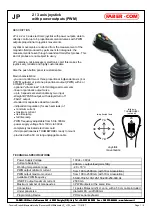
12
MS4PMUHVT Multi-Stage Electronic Temperature Control with Relay Pack Product/Technical Bulletin
Alarm Management Functions
AH High Temperature Alarm
establishes the
temperature relative to Setpoint (F° or C°) at which the
control goes into a high temperature alarm condition.
(The temperature value is added to the Setpoint.)
AL Low Temperature Alarm
establishes the
temperature relative to Setpoint (F° or C°) at which the
control goes into a low temperature alarm condition.
(The temperature value is subtracted from the
Setpoint.)
AH, AL High and Low Temperature Alarms
are
disabled during defrost and for 20 minutes after the
defrost cycle. These alarms are also disabled for
20 minutes after startup.
Ad Alarm Differential
establishes the difference (F°
or C°) between the alarm activation temperature and
the alarm deactivation temperature.
Alarm Differential Example - Cooling Applications:
Setpoint = 40°F
High Temperature Alarm
= 15F°
Alarm Differential
= 2F°
When the room temperature exceeds 55°F
(40+15=55°F) for a time greater than the
alarm
time delay
setting, the alarm message is
displayed; however, it will reset after the
temperature drops below 53°F (40+15-2=53°F).
At Alarm Time Delay
establishes the time delay
(minutes) between reaching a high or low temperature
alarm condition and displaying an alarm message on
the display. This function reduces alarm oscillation and
nuisance alarms caused by temperatures that
temporarily exceed alarm setpoint temperatures.
Binary Input Functions
iF Binary Input Mode
allows selection of how the
Normally Closed (N.C.) binary input activates the
stage control contacts.
Binary Input Mode can be disabled or can provide one
of three predetermined responses to the binary input.
(If a set of stage control contacts are used to control
an external alarm, this function should be disabled.)
Shutoff and Alarm Signaling
- If the binary input
contact is open for a time longer than that set
through the Binary Input Time Delay, the stage
control contacts are switched Off, and an alarm
message (A1) is displayed.
Setback
- If the binary input contact is open for a
time longer than that set through the Binary Input
Time Delay, the setpoints are shifted by Setback.
Reverse setpoints (heating) decrease. Direct
setpoints (cooling) increase.
Remote Shutoff
of the outputs. - If the binary
input contact is open for a time longer than that set
through the Binary Input Time Delay, the stage
control contacts are switched Off.
id Binary Input Time Delay
establishes the time
delay (minutes) between the binary input signal
reaching the control and activation of the response
selected by Binary Input Mode.
Sb Setback
determines the value of the Setpoint shift
when the binary input is open and Setback is the
response selected by Binary Input Mode.


































